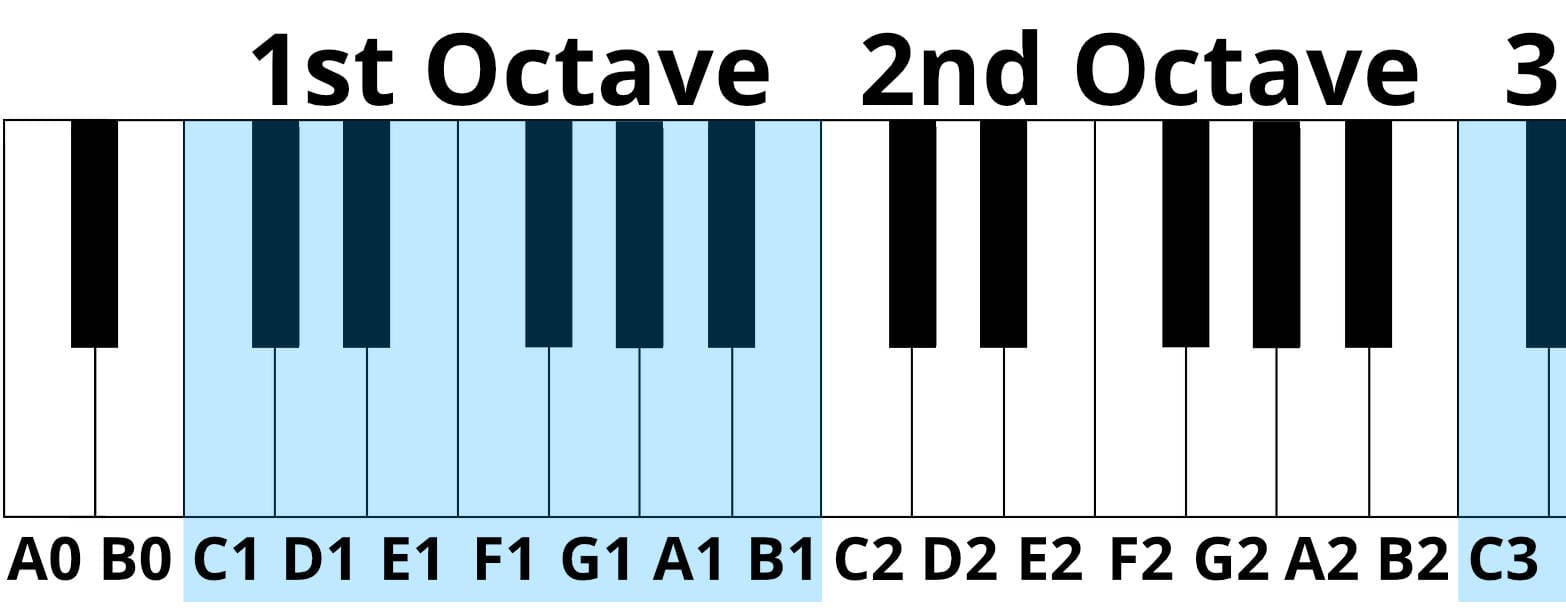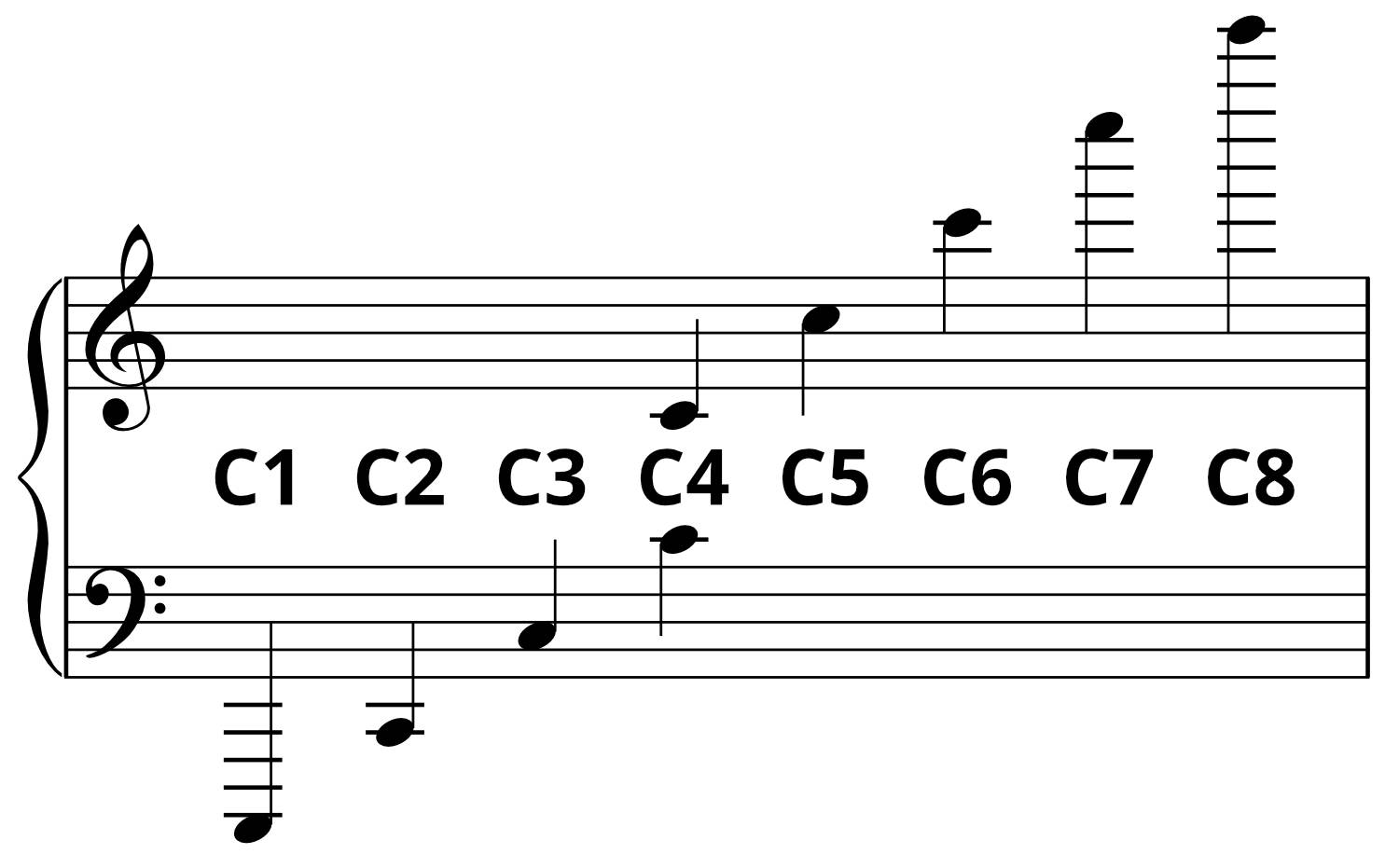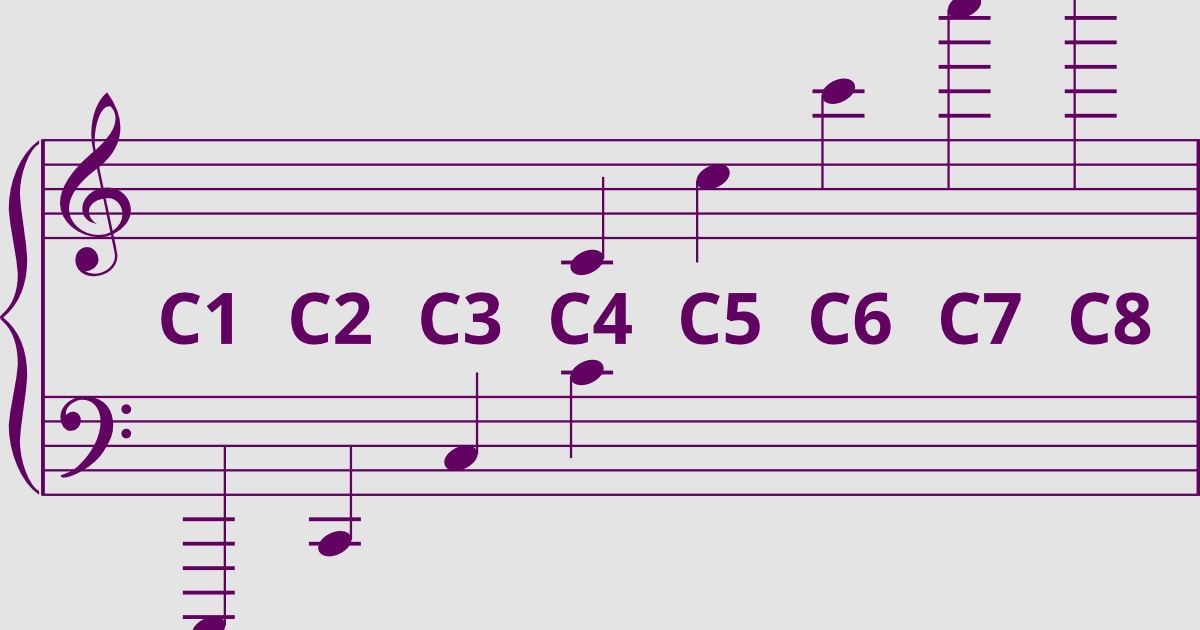An Easy Guide to Scientific Pitch Notation
Have you ever heard someone mention the notes C5 or A2 and had no idea what it means? It's actually from the American system for notating pitches, called Scientific Pitch Notation (SPN). This sounds really complicated, but in reality it's really simple! All it takes is a basic knowledge of numbers and letters and applying them to the piano keyboard.
Here's your easy guide to understanding Scientific Pitch Notation.
What is Scientific Pitch Notation?
A quick definition: Combine the name of the pitch (letter) with the octave the pitch is in (number). This letter and number combination is the "scientific pitch notation" and indicates a precise pitch. For example, C4 = Middle C on the piano. C4 refers to this exact C, not a lower or higher C.

Full piano keyboard (all 88 keys) showing the different octaves.
Let's go into more detail with some background information.
Letters in Scientific Pitch Notation
The first part of SPN is the pitch name. This comes from the Musical Alphabet, where letters represents a specific sound or “pitch”. The Musical Alphabet is the first 7 letters of the Latin alphabet: A, B, C, D, E, F, G (repeated over and over). As you move from A to B to C and so on, the pitch gets higher.
After G, the next higher letter is again called A, and the letters continue in order (repeated over and over). As the letters repeat, the pitches “repeat”, too. Two different As sound very similar to each other (almost the same!), except one is lower than the other. All As sound very similar, and the same goes for all Bs, all Cs, and so on.
The difference between one A and the next closest A is one octave. Octaves are where we get the number in SPN (more on that below).

The Musical Alphabet on the Piano Keyboard
The piano keyboard is a great visual for understanding both the musical alphabet and SPN, so I'll use it to explain both in more detail.
The white keys on the piano represent the musical alphabet: A, B, C, D, E, F, G (repeated over and over). The lowest white key on the left edge of the piano is A. The next white key to the right is B, then C, D, E, and so on. After G, the next higher white key is A, and it repeats over and over all the way to the highest key.
Because the keys represent the musical alphabet, the pitch of each key rises as you move from A to B to C and so on (just like with the letter names). And once again, all A keys sound very similar, as do all B keys, all Cs, etc.
Side Note: The black keys of the piano represent semitones (half steps) between some of the letters. They're organized in groups of 2s and 3s, making it possible to identify keys of the same pitch by sight alone. For example, all Cs are immediately left of a 2-black-keys group.
Numbers in Scientific Pitch Notation
The second part of SPN is the octave number.
Each group of unique letter names spans one octave, and the first repeated letter starts the next octave (for example, C and the next closest C are one octave apart). Octave 1 starts with the lowest C on the piano, Octave 2 starts with the next C, and so on. (This is why the piano is a great visual for explaining SPN.)
Due primarily to the major scale in music theory, all octaves in SPN start with C. The first octave begins with the lowest C key on the piano. As the C in the 1st octave, it is called C1. The next white key is D1, then E1, F1, G1, A1, and B1.

The lowest octaves on the piano (naming all white keys in Scientific Pitch Notation)
When you reach the next C key, you’re now playing the 2nd octave, so these keys are called C2, D2, E2, F2, etc. You can continue this pattern until you reach the highest white key (C8).
What about the keys below C1? Because they are lower than the 1st octave, the two lowest white keys on the piano are called A0 and B0 in Scientific Pitch Notation. These are Octave 0 because they are the lowest range of what human ears can actually perceive as unique pitches.
That’s It!
Yes, that's it! Combine the letter name of any pitch with the octave number the pitch is in, and that is its Scientific Pitch Notation.
Using this system, you can identify any specific pitch with just a letter and a number. You can also match or identify any given pitch by counting up the octaves and keys from C1 on the piano.
What About Sharps and Flats?
To label sharp or flat notes with SPN, put the flat sign or sharp sign between the letter and the number (for example, C#5).

Why Do We Use Scientific Pitch Notation?
Scientific Pitch Notation is useful not only for piano but also for singing and many other instruments, so it's a good idea for all musicians to become familiar with it. One useful tip is to memorize that C4 is Middle C (the note in the exact middle of the Grand Staff), so you can always refer to that when someone mentions B3 or F7 or another note.
Now, when a voice teacher excitedly tells you their newest student can sing C2, you’ll understand their excitement (not many people can sing so low!). Or when you’re considering learning a new instrument and discover that a clarinet can play from E3 to C7, you’ll be impressed to realize that its range is nearly 4 octaves!
The Benefit of Scientific Pitch Notation
SPN makes things far less confusing when musicians communicate with each other. C5 is much more specific than C: a "C" could refer to any C, but if someone mentions C5, you know it’s the C in the 5th octave, and you can determine exactly what pitch that is. It’s extremely useful when you’re trying to match or identify both the pitch AND the octave, which musicians have to do all the time.
“G2” is very specific while “bass G” or “low G” is unclear. Is "bass G" the G on the bottom line or top space of the bass staff? Is "low G" one of the bass Gs, or is it the lowest G you can sing or play on your particular instrument? (That varies widely!) Ask someone to play you a G and they’ll play whichever G they want, but ask them to play G2 and they’ll play the exact pitch you wanted to hear.
And if they don't know what you mean, now you'll be able to teach them about Scientific Pitch Notation!

Why is It Called Scientific Pitch Notation?
One of the commenters below asked this excellent question, so I decided to post the answer here.
Scientific pitch notation was invented to be a companion to scientific pitch standard (a system for measuring pitch frequencies). Pitch frequencies are how many times a sound wave vibrates per second (measured in Hertz, abbreviated Hz). Every musical pitch vibrates at a unique frequency, so to help musicians play in tune with each other, various systems of standardizing pitch frequencies (like scientific pitch) have been developed over time.
Scientific pitch standard measures C4 ("middle C") at 256 Hz and all other Cs as powers of 2. This system was appreciated for its mathematical idealism, but it is not commonly used today. Today, the now globally dominant pitch tuning system is international pitch standard (A4 = 440 Hz). For reference, in scientific pitch, A4 = 430.54 Hz (assuming equal temperament tuning ratios), and A4 in Verdi tuning = 432 Hz.
It's important to recognize that different tuning systems change only the tuning of pitches, NOT their names. A4 is still A4 whether it is tuned to 430.54 Hz, 432 Hz, 440 Hz, etc.
Why does this distinction matter? If two musicians use international pitch standard tuning, and both musicians play A4, the two A4s will sound exactly the same (a perfect blend!) because they are vibrating at the same frequency (440 Hz). But if one musician uses international pitch standard and the other uses scientific pitch or Verdi tuning, and they both play A4, the A4s will sound nearly the same, but slightly out of tune with each other because they are vibrating at different frequencies.
To summarize, Scientific Pitch Notation was created as a companion for a tuning system called scientific pitch. The difference between them is that scientific pitch notation is a system for naming pitches, and scientific pitch is a system for tuning pitches. As this can get confusing, both Scientific Pitch Notation and Scientific Pitch Standard can go by additional names:


personally, I think SPN is a brilliant way of expressing musical notation. 🎼
Agreed! It makes it so easy to communicate with other musicians and across instruments.
Every definition or explanation of scientific pitch notation SHOULD MENTION and show a picture (like you did of the piano keyboard) showing OCTAVES CHANGE ON C in scientific notation.
Try try to imagine that one might, as I did, think that the numbering began with A – the first letter of the alphabet. But the note after B3 is not C3, is it?
It took me a while – until I found your picture – to confirm that was the case, because so many just so “C”.
Yes – Each new octave number in SPN starts with C, so the next tone up after B3 would be C4. You’re right that this can easily be confusing without a decent explanation and visual reference. I’m glad my picture was helpful for you!
You’re better off thinking in integer notation anyway (C=0…B=11), then most things become much simpler. Using letters for pitch classes makes little sense in Equal Temperament, with accidentals pinned to a single key. This is just a historical artefact.
Imagine if rulers had letters, with some of them duplicated but others not, instead of numbers.
That’s why there’s a letter followed by an octave number in SPN… How’s remembering 88 numbers easier? Some keyboards have fewer than 88 keys, too.
loud and clear with this teaching
Why is this referred to as Scientific Pitch Notation rather than just music pitch notation?
Great question! Scientific pitch notation was originally meant to be a companion to a standardized system of tuning pitch frequencies, called “scientific pitch”. Scientific pitch measures C4 (“middle C”) at 256 Hz and all other Cs as powers of 2. This system is not commonly used today; the now globally dominant pitch tuning system is international pitch standard (A4 = 440 Hz). For reference, in scientific pitch, A4 = 430.54 Hz (assuming equal temperament tuning ratios).
So, scientific pitch notation is a system for naming specific pitches, and it was intended for use as a companion to scientific pitch (a system for tuning pitch frequencies). With SPN, A4 is still A4, whether it measures at 430.54 Hz or 440 Hz. The difference in Hz reflects only a slight change in their tuning (A440 sounds a little sharper than A 430.54).
Both Scientific Pitch Notation and Scientific Pitch go by additional names to help reduce confusion – Scientific Pitch Notation (SPN) may also be called American Standard Pitch Notation (ASPN) or International Pitch Notation (IPN), and Scientific Pitch may also be called philosophical pitch or Sauveur pitch.
It’s also called Scientific Pitch Notation to distinguish it from other systems, such as Helmholtz Pitch Notation which uses upper- and lower-case letters and accent marks instead of numbers.
I watched a lecture on a person teaching the Guitar. The Guitar Frets are a semitone apart.
He was proposing going up and down the strings calling out just the the note.
My point was “What is the purpose of that, when it is unrelated to notes on a staff in sheet music”.
Scientific Notation must be added to the recital how else does the person know which ABCDEFG they are memorising the position of. When relating the notes to sheet music.
The guitar is a transposing instrument: the notes on the staff are an octave above what a guitar plays in standard notation. So, if you play the highest pitched string in standard tuning, it is notated as an E5, but the guitar played an E4.
As for the notes, once you know the notes and the intervals, it is not an issue: there are many ways to play most notes that are playable on a guitar, so the fret and string being used has no singular relationship to notation: the aforementioned high E string’s note can be played on the other strings too (all of them, if there is a 24th fret on the low E).
Scientific Notation is not used for most methods, and for single instruments, the conventions are for the relative differences, for example, the low and high E strings on guitar, the first and second octaves of flutes, and transposing instruments have their own multiple conventions.
As for guitar, depending on the type of guitar, the note names themselves are not needed, as some guitar playing requires being able to change keys to accommodate others, and instead of the precise note, they rely on the scale degree (see: Nashville Number system), so they may be able to use notation, but then instantly transpose it into another key on demand or rely on another calling out the numbers.
Bri, I’m just this year discovering your wonderful post, so am late to the group. As an 87 year old trying to teach myself music from scratch, I made the same mistake as tracy rupp (above), and your post saved me. It’s a gold mine of information for me. Thank you ever so much. My dream is, if I live long enough, to someday be able to play cello. I wish I could have a teacher, but google is my friend, and I’ve flooded it with questions. The study has saved me from multiple griefs, and whether or not I’m ever able to play cello, the journey, though lonely, is beautiful! Thank you for your part.
Thank you and you’re welcome! Wishing you the best on your musical journey.
Hi Barbara, I am 86 and learning guitar, self taught. When I did science at school ‘middle C was 256 cycles per second(Hz), since this is a measurement it cannot change, therefore it is music that has changed. I wonder how much this has to do with the electronics industry?
I admire you for learning something new. You give me motivation to keep going!
When reading staves, is there an easy way to quickly read note positions without having to count the intervals up the ledger lines below and above the original 5? Thanks in advance
You can learn to quickly identify intervals by sight without having to count ledger lines. For example, all odd intervals (3rds, 5ths, 7ths, etc.) will “match”, meaning both notes are on lines or in spaces. All even intervals (4ths, 6ths, 8ths/octaves, etc.) will not match, meaning one note is on a line and the other is in a space. That is also true for notes in the ledger lines/spaces.
From there, you can identify other traits at a glance – for example, 3rds are either one line to the very next line, or one space to the next. 5ths match and have one line or space between them. Etc. Once you get to the larger intervals that are a little harder to identify quickly, context matters. Usually, octaves or 6ths are most common, followed by 7ths (although 7ths are more common in some contexts, like jazz).
You can learn to read intervals in the ledger lines/spaces just as quickly as you can learn to read single notes in the staff. I have a series of interval reading printable practice pages that include more tips, if you’d like to check them out here. The full collection of over 100 practice pages and tips is available here.
Every time I write down a note/stop combo to identify a pipe for my organ tech to tune I have a meltdown, I’ve seen notes notated so many different ways. How do people notate which physical key it is? I would assume you use C1…C#1…D1…. for notes in the lowest octave of a manual or pedalboard and increment for subsequent octaves, but we’re not talking SPN because in reality there is no 1-to-1 mapping of physical key to pitch in an organ. Just curious….thanks
Very good question. Unfortunately I do not play the organ, but your suggestion makes sense. If I played organ, I’d refer to a particular key as something like “Great – C1” or “C1 on Great”, meaning the first (lowest) C on the Great manual. As you said, this wouldn’t really be SPN, but from a visual perspective of the keyboard, it would follow the same pattern.